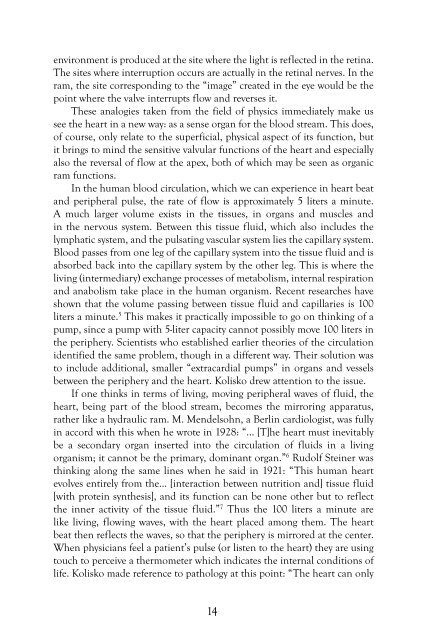When Healing Becomes Educating, Vol. 6 - Waldorf Research Institute
When Healing Becomes Educating, Vol. 6 - Waldorf Research Institute
When Healing Becomes Educating, Vol. 6 - Waldorf Research Institute
Create successful ePaper yourself
Turn your PDF publications into a flip-book with our unique Google optimized e-Paper software.
environment is produced at the site where the light is reflected in the retina.<br />
The sites where interruption occurs are actually in the retinal nerves. In the<br />
ram, the site corresponding to the “image” created in the eye would be the<br />
point where the valve interrupts flow and reverses it.<br />
These analogies taken from the field of physics immediately make us<br />
see the heart in a new way: as a sense organ for the blood stream. This does,<br />
of course, only relate to the superficial, physical aspect of its function, but<br />
it brings to mind the sensitive valvular functions of the heart and especially<br />
also the reversal of flow at the apex, both of which may be seen as organic<br />
ram functions.<br />
In the human blood circulation, which we can experience in heart beat<br />
and peripheral pulse, the rate of flow is approximately 5 liters a minute.<br />
A much larger volume exists in the tissues, in organs and muscles and<br />
in the nervous system. Between this tissue fluid, which also includes the<br />
lymphatic system, and the pulsating vascular system lies the capillary system.<br />
Blood passes from one leg of the capillary system into the tissue fluid and is<br />
absorbed back into the capillary system by the other leg. This is where the<br />
living (intermediary) exchange processes of metabolism, internal respiration<br />
and anabolism take place in the human organism. Recent researches have<br />
shown that the volume passing between tissue fluid and capillaries is 100<br />
liters a minute. 5 This makes it practically impossible to go on thinking of a<br />
pump, since a pump with 5-liter capacity cannot possibly move 100 liters in<br />
the periphery. Scientists who established earlier theories of the circulation<br />
identified the same problem, though in a different way. Their solution was<br />
to include additional, smaller “extracardial pumps” in organs and vessels<br />
between the periphery and the heart. Kolisko drew attention to the issue.<br />
If one thinks in terms of living, moving peripheral waves of fluid, the<br />
heart, being part of the blood stream, becomes the mirroring apparatus,<br />
rather like a hydraulic ram. M. Mendelsohn, a Berlin cardiologist, was fully<br />
in accord with this when he wrote in 1928: “... [T]he heart must inevitably<br />
be a secondary organ inserted into the circulation of fluids in a living<br />
organism; it cannot be the primary, dominant organ.” 6 Rudolf Steiner was<br />
thinking along the same lines when he said in 1921: “This human heart<br />
evolves entirely from the... [interaction between nutrition and] tissue fluid<br />
[with protein synthesis], and its function can be none other but to reflect<br />
the inner activity of the tissue fluid.” 7 Thus the 100 liters a minute are<br />
like living, flowing waves, with the heart placed among them. The heart<br />
beat then reflects the waves, so that the periphery is mirrored at the center.<br />
<strong>When</strong> physicians feel a patient’s pulse (or listen to the heart) they are using<br />
touch to perceive a thermometer which indicates the internal conditions of<br />
life. Kolisko made reference to pathology at this point: “The heart can only<br />
14

















